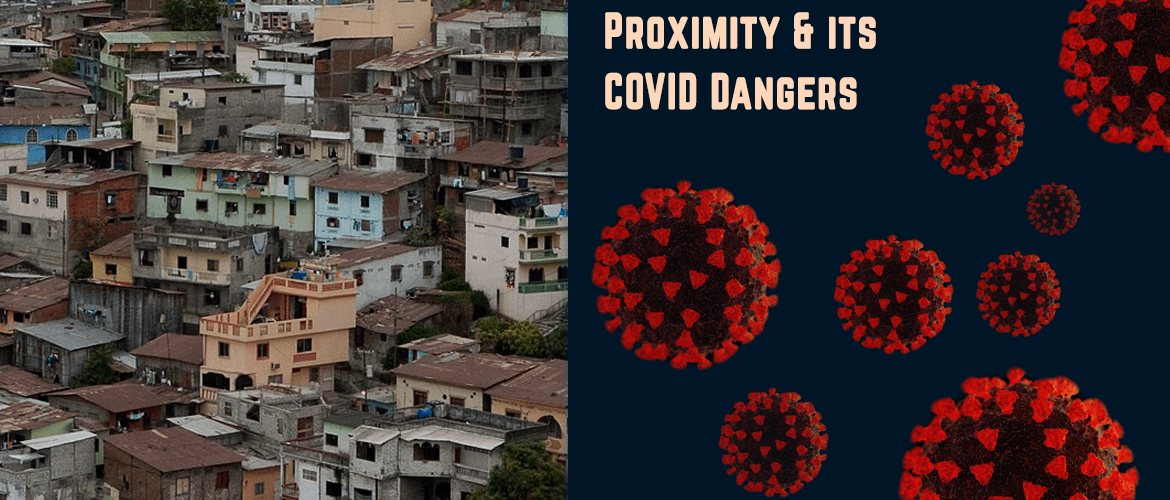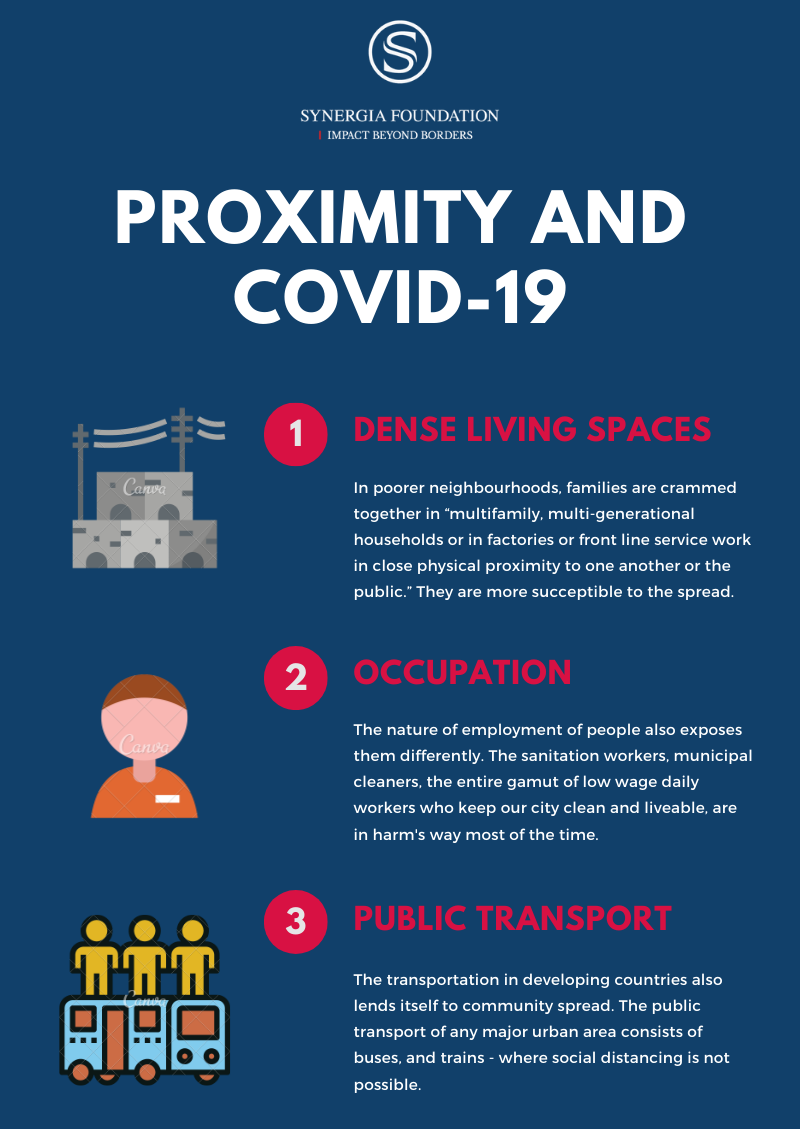Proximity and its COVID Dangers
April 22, 2020 | Expert Insights

Riding on Societal Compulsions
Rural societies and those in remote mountainous areas, where it is feasible to create space between dwelling units, are showing a much slower pace of spread; closely packed urban slums are not so fortunate.
One of the reasons for the increased spread of COVID-19 in urban areas is that they are all densely populated. The most central and dense cities are the ones that have been most affected - such as Wuhan, London, Paris, New York, Madrid, Rome, Mumbai and New Delhi, to name a few. In India, it can be seen that the highest number of cases are present in Maharashtra, Delhi, and Tamil Nadu - states with cities that are metropolitan hubs. Vast slums like Dharavi in Mumbai, already infected and under a total lockdown, are ticking time bombs.
The geography of COVID
Pandemics feed off densely packed spaces has been witnessed historically. The 1918 Spanish flu pandemic that swept through the working-class neighbourhoods in Pittsburgh illustrates this very clearly.
While all high population densities are at risk, the difference lies in the nature of the density. Some places are dense yet rich, and there are places that are dense but poor. A report by CityLab shows how in New York, the COVID-19 cases are not high in uber-dense Manhattan but rather in the less-dense outer boroughs, like the Bronx and Queens. It is essentially the rich and poor divide which ultimately creates greater vulnerability to the spread of viruses.In poor neighbourhoods, families are crammed together in “multifamily, multi-generational households or in factories or front line service work in close physical proximity to one another or the public.”
The effect of the pandemic can be seen in the reports on Soweto in South Africa and Payatas in Manila. The first few recorded cases of COVID-19 have come out of Worli-Koliwada slum and increased from one to 68 in less than a week.
As per India’s 2011 census figures, 65 million people, or 17 percent of the country's urban population, live in slum settlements. The most threatened are these low-income ghettos, with marginalised access to basic sanitation and water supply. With community water taps and community toilets, there is no aspect of daily life where close crowding is not a feature or can be avoided.
Differing exposure risks
Apart from closed spaces and a lack of resources, there is another problem that prevails in dense living areas. The nature of employment of the inhabitants has a far greater risk of exposurethan their richer counterparts. The sanitation workers, municipal cleaners, hospital garbage disposers, the entire gamut of low wage daily workers who keep our city clean and liveable, are in harm's way most of the time. There is little effort to address these threats as reported by the Coalition of Human Needs, a collection of national organisations working together to promote public policies.
These dwellers are obviously, not to blame. Given the ground reality, they have to go to work to earn for themselves, and additionally, cannot benefit from social distancing. "We are talking about a slum where 10-12 people live in 10x10 feet tin hutments. You can’t expect them to sit at home all day long," Vinod Shetty, director at the non-profit Acorn Foundation, told Bloomberg.
While some portions of the slums have been quarantined, there is a chance for it to get a lot worse. After the lockdown ends, it could also be the hotspot for the second wave of infections.
The second wave
China and Singapore are seeing what is being termed as the second wave of infections. The north-eastern Heilongjiang province in China, which borders Russia, has reported cases that seem to be driven by infected travellers from Russia.
The second wave comes from those who are susceptible to infections, getting infected by imported cases from other countries that are in their first round of infections or being infected but asymptomatic. Singapore has also reported cases at several dormitories that house foreign workers.
It is possible that once lockdown is lifted and air and train travel are restarted, the likelihood that infections will spread is high. A large proportion of slum dwellers are closely connected with the transportation business, be it the porters and other staff at the railway station, the bus station or the airport. Mumbai has Asia's biggest slum, Dharavi along with India’s second busiest airport, and a sizable number of Dharavi inmates work at the airport.
The transportation in developing countries also lends itself to community spread. The ramshackle public transport of any major urban area in an emerging economy is bursting at the seams. While proper distancing may be effected in air travel by accommodating less number of passengers while doubling the cost, the same principle will be impossible to implement in public transport. Indian railways are conducting elaborate exercises to ensure social distancing once the system is thrown open. But, if the unruly crowds witnessed in Mumbai, who thronged in thousands to a railway station when rumours of trains restarting were spread by a local TV station, are any indicator, then concerned authorities need to prepare for the worst.
Assessment
Travel by mass transportation system by road, rail and air is a big cause for the second wave of infections. Thus discontinuing air travel from places still seeing cases should be enforced until the number of cases reduces the world over. Strict testing should be enforced before people are permitted to leave the cities/countries.
Rich or poor, urban or rural, the reality is that pandemics are here to stay. Basic precautions like social distancing will be the new normal if mankind has to survive and get along with the daily routine of life. The poor too will have to adopt innovative measures, and the government has to ensure that they are given the maximum attention when in such dire straits. Staggered timings for water collection from community taps and use of public toilets, volunteers / local leaders to regulate the use of such facilities, public messaging to drive home the criticality are some ad hoc measures which need to become the norm in close communities. Isolated inmates of slums will have to be kept in public isolation facilities until they test –ve or +ve.
Public transport will have to run at 1/3 capacity, which will have to be strongly enforced by the police. Metros, with their access control, are the best suited.The opening will have to be staggered with no transport links to existing hot spots. Technological solutions will be needed to generate time slots for crowd management.









Comments